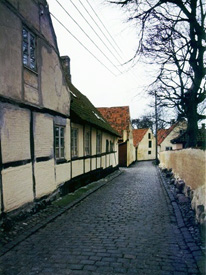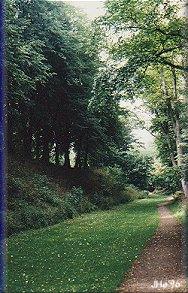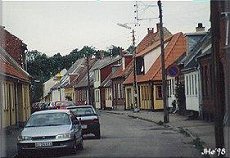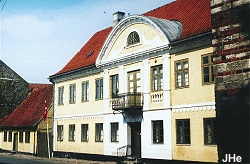insula-moenia.dk

insula-moenia.dk

After each King mentioned you'll find the period of time in which he reigned.
Stege began as a small fishing village at Dybsbroen(+). The village eventually grew and Dybsbrostrædet(1) was born. Then came Langestræde(2) (Langgade today) and from there on the village grew and became a town.
Stege presumably comes from the old word "Stickæ" or "Stike"which means "in water rammed down poles" and is related to the findings of sharpened poles in the inlet of Stege which were used to stop enemies such as "Venderne" - the Vendes.
Stege Castle or Stegeborg(a) as its real name was, was build as a wood-castle at first but during the years 1225 until 1246 the castle was transformed into a brick-fortress by its owner at that time: Jacob Suneson af Hvideslægten. In about 1360 Valdemar Atterdag(1340-1375) strengthened the fortress so that the walls became 5 ells (=225 inches or 5,63m) thick and the key almost 1 ell (=45 inches or 1,13m) long. After Valdemar Atterdag the castle had several owners until the year 1534.
In 1268 Stege got its municipal charter by Erik Klipping(1259-1286).
Another construction that Jacob Suneson contributed to in Stege was Stege church, Sct. Hans Kirke(b) which also dates back to the 13th century. Stege church originally had twin-towers, but those were destroyed together with the churchbell during a fire in the 15th century. During the middle ages up to the 19th century the dead were buried under the church floor and right outside the church, but as the amount of corpses increased the stench finally was unbearable both inside and outside the church and the cemetery was moved. The new cemetery was founded right outside of Stege´s eastern wall and most of those buried inside of the church were moved. But still you will find two sarcophagues with the earthly remains of the family Moltke from Marienborg inside.
Stege once had two churches, one is still standing, but Sct. Gertruds Church(f) has long gone.
Nevertheless this church was a really wealthy church and was situated behind Gåsetorvet(e) on the
east side of the town. Today you will find a parking lot(f) where it
once lay. It began to go slow for the church after the reformation in 1536. So during the 1600s the church
decayed into ruins and after the war against the Swedes in 1679, it was hard to see if there had ever been a
church there. So using the bricks of the church and with some financial help from the King,
Stege´s church of today, Sct. Hans Church(b), got a new choir. Sct.Gertrud was the patron of
travelers and farmers and at the square/marketplace Gåsetorvet farmers gathered and sold their
live poultry.
Behind Gåsetorvet up against Sct Gertruds Church once lay Sct
Annægården where monks practiced relief of the poor and took
care of the sick, though not those with leprosy. Those were taken care of
outside Stege.
Another old construction in Stege which is still standing is Hestgardeporten(g) and is dated back to the 13th century, inside the gate the farmers placed their horses and carriages while they were on Gåsetorvet to sell or buy goods.
In the end of the middle age (1430-1530) Stege reached its highest point of wealth ever. A third of all fish (Herrings) on the Danish fish market was from the fishermen from Møn! That is why Møn's shield contains three herrings.
Around the year 1430 Steges rampart and moat were established (see the thick red line on the map). On top of the rampart was build a town wall which unfortunately were destroyed in "the biggest robbery in Møns history" as it is referred to (More on that later). Three towers were raised one for each approach road, except for the one still standing today Mølleporten(d), there was also one at the end of Skammestræde(7) and one at the end of Langestræde(2). Photo of the The Moat to the left.
In 1510 Stege was attacked by the Lübecks but the fortress held the battle and the Germans had to withdraw. They did however destroy Borre in the same raid. Borre was the second largest town back then.
When people entered Stege from the west they had to walk though the castles farm, to let the pailiff and his men examine the goods that was to be sold on the marked. The castles owner had the first pick, only the goods that he did not want to buy was brought into Stege. This ended in 1663 when the feudal lordship was put to an end. The place where this happened is where Rosengårdsstrædet is today, then it was called Bystrædet (9).
Other streets and buildings that dates back to the middle ages are:
Peblingerende(6) (which then only was a small path to the beach),
Rådhusgade or Skammestræde(7) as it was called then (Picture to the right).
Torvestrædet(3) was most likely used as a link between the town square and the church.
The Town Hall once was situated in the middle of the town square but it was burned down in 1659 by the
Swedes and all of Steges papers were lost. A new Town Hall was build in 1854, but was later used as a
police-station.
The year 1534 was the year that the citizens of Stege blew up they own castle! But it all started one year
earlier in 1533 when the King Fredrik the 1st died (1523-1533), the citizens and the farmers wanted their
old king back which had gone into exile in 1523, but that of course couldn't the nobility and the priests allow
since Christian the 2nd(1513-1523) had been much too kind towards the ordinary people of the land and
that effected the status of the more wealthy and powerful men of Denmark. So war broke out and a day in 1534
when the owner of Stegeborg: Anders Bille had gone on a visit to his manor Søholm (Gjorslev
today), he let 4 of the castles' noblemen and 4 citizens in charge of the castle, but at the same moment he was
out of sight the bailiff of the castle was tricked into Stege itself and killed. The 4 citizens which had been
let in charge committed treachery and opened the castles gates and in rushed the citizens of Stege. They robbed
the castle and finally blew it up!
But all good must come to an end. The leader of the German army, count Christoffer af Oldenburg
suddenly switched side and Anders Bille joined him. Anders Bille got half of the robbed goods back, which had
fallen into the custody of the count and used his new found power to get back at the treacherous citizens of
Stege. The 4 men who had opened the gates to the castle where hanged on Stege's square/marketplace(c). The castle however was never rebuild, though there were several attempts to do so.
In the end of the 16th century the herring fishery slowed down so much that it brought Stege to its knees. The many wars of Christian the 4th(1588-1648) enforced the crisis and when the citizens of Stege did not have any fields to grow corn on, the king gave them the field right outside Stege called Rødstensmarken. Today you will find a street called Rødstensvej there. Rødstensmarken was situated behind the area where Stege's mills where located called Mølleparken, and it is from here the name of Mølleporten derives (Mill = Mølle). Where Mølleparken once lay the cemetery lies today.
The years 1685-97 became the worst 12 years of Steges history thanks to the
colonel von Plessen, chief of the royal Life Guards on horse. He became
head of the county on Møn and with him came 4 of the Horse Guards 6 battalions,
to which he had to get housing. That was the beginning of the misery. In 1690
Plessen tore down the two gatetowers at Skammestræde and Langestræde and the
town wall to get stones to improve on his summer residence Nygård (Now known
as Marienborg) and to build 400 chimneys to
the Guard Houses, each chimney needed 300 stones. It is this demolition of
Stege's fortress that is known as the "the biggest robbery in Møns history".Though
in the last standing gatetower he established a prison with two light and
two dark cells. Today nothing but the doves lives inside these walls.
When the king heard of the terrible things "The evil Plessens" terror
regime had done to the island he spared the people of Møn of taxes for 2 years,
but it would take 100 years before Møn was fully recovered from the damages
caused by Plessen.
During the 17th century the towns hopgarden were situated between Møllebrøndsstræde and the rampart. The garden provided the towns breweries with hop.
Other old buildings in Stege:
1703 - Navigationsskolen, this building was build on the initiative by king
Fredrik the 4th and was originally a school of navigation. Around the
same time some of the Guard-houses was rebuild to boatswain houses. The attempt
to establish Stege as a forum for sailors failed and the school only graduated
6 mates in 20 years! So the navigation school then became a house of correction/penitentiary
and draper's shop. The penitentiary once had a presumed Danish princess as
its prisoner(Read the story here).
Since 1851 it has been nursing home for mentally disabled.
1813 - Empiregården (picture to the right), originally a merchant house with
a storehouse for storage and even it's own cafe/bar. Since 1958 the local
museum is located here. For Those who understand Danish I really recommend
you to read the Book "Empiregaarden i Stege" by Kirsten Lütchen-Lehn,
as I found it really enjoyable. Here you can read about how it was to
live and work as a merchant in Stege around 1770 - 1832.
1848 - Toldbygning, originally a customs house but was closed in about 1970.
Now you'll find the tourist office here, they have housed the building since
1991.
1855 - Gult Pakhus, this building once were a part of a merchants house, but
was sold in 1936 as a separate building.
1865 - Stege Skibsværft, Stege's shipyard has been featured in a movie about
Paul Gaugin (French painter, 1848-1903) from 1980 with Donald Sutherland
as the main character. "Paul Gauguin - The Savage Dream" (1988).
1871 - Birkelyhjemmet, originally an orphanage build by A&V Hage.
The family Hage has influenced Stege both in name and action since
the 17th century. In 1924 Møns local government took over the building and
today it is a nursing home.



